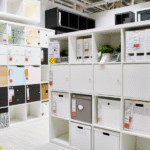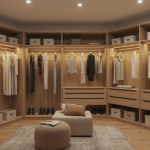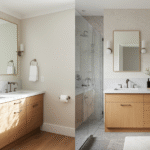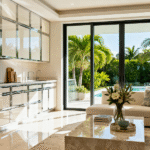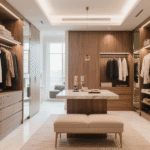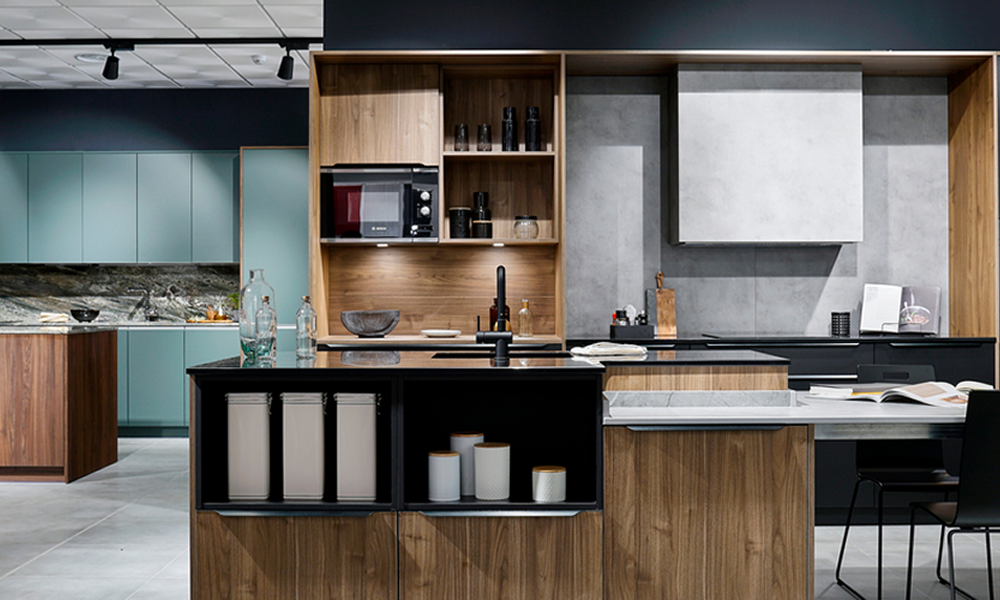
10 Signs It’s Time to Upgrade Your Kitchen Cabinets
Sep 04, 2025
Kitchen Cabinets play the most integral part of your culinary space. But just like any other working part of your house, they may exhibit symptoms of weariness, and then they might no longer suit your needs. Knowing when to upgrade will help you avoid continuous frustration and maximize your kitchen investment.
Specific indicators are apparent, such as doors that do not close well and noticeable damage. Some of the others are not as obvious as the old-fashioned style that makes your whole kitchen look outdated, or storage that no longer suits your life. Knowing the tell-tale signs allows you to make informed decisions about repairing, refacing, or replacing the kitchen cabinets.
Clear Signs For a Kitchen Cabinet Upgrade
So, how do you identify the need for a kitchen cabinet upgrade? Here are the top warning signs that you should know about:
1. Doors and Drawers Won’t Stay Closed
Doors and drawers that won’t remain shut are among the most frustrating cabinet issues. Damaged hinges, a skewed door, or a bent cabinet typically cause this issue. Although this may appear like a minor nuisance, it is an indicator of deeper structural problems.
Hinges become worn out over time, particularly on cabinets in regular use. Repeated opening and closing of the door will eventually loosen the screws and damage the hinge system. Likewise, the drawer slides may be bent or full of debris and may not move smoothly.
In other cases, two factors that might have contributed to the movement or warping of the cabinet boxes are exposure to moisture or the settling of the house. When that occurs, the doors and drawers cease to fit correctly within their frames and can no longer close flush.
Some of these problems can be solved by changing hinges or hardware, but some ongoing problems may indicate that the cabinets are worn out over time.
2. Noticeable Water Damage or Warping
Kitchen cabinets, particularly those composed of particleboard or low-quality materials, are the enemy of water. Water damage can be indicated by the presence of signs such as swollen or bubbled surfaces, peeling veneer, dark stains, or a musty smell in the cabinets.
Cabinets below the sink, around the dishwasher, and windows where condensation is common are the most common areas where water damage may occur. Even minor leaks can be extremely harmful in the long run, as moisture seeps into the cabinet materials, causing them to swell and decay.
Another evident sign of a moisture problem is distorted cabinet doors. Doors that are not flat on the cabinet frame and exhibit visible bowing indicate that the wood has absorbed moisture and expanded unevenly. This not only appears to be an eyesore, but it also interferes with the cabinet’s functionality.
Water damage rarely corrects itself, and in most cases, it worsens over time. When moisture damages the materials, they become prone to further damage in the future and could be a source of mold or mildew, a clear sign to get a custom kitchen cabinet done by a reputable manufacturer.
3. Outdated Style That Affects Your Home’s Value
The trends in kitchen fashion change over time, and what was in fashion two decades ago can now make your entire house appear outdated. Personal desire is one thing, but there are types of cabinets that can even influence the resale value of your home.
The 1980s and 1990s cabinets feature these distinctive elements, instantly identifying a kitchen: golden oak, cathedral raised panel doors, and brass hardware. On the same note, the dull white laminate cabinets, which were a trend in the early 2000s, have the potential to make a kitchen seem cold and institutional.
More than just aesthetics, old cabinets can lack the storage options and functionality currently desired by homeowners. Soft-close, full-extension drawers and customized storage accessories are a common feature in modern kitchens that were not commonly found in older cabinets.
When your kitchen is stuck in a time warp, updating your cabinets can significantly modernize the space and make your home more appealing to potential buyers. So, this is the right time to get a professional help from the leading cabinetry manufacturers who can offer you a custom solution.

4. Insufficient Storage for Your Current Needs
As families grow and lifestyles change, storage needs evolve. The cabinet configuration that worked when you first moved in may no longer accommodate your current belongings and cooking habits.
Common storage problems include insufficient pantry space for bulk shopping, a lack of specialized storage for small appliances, inadequate drawer space for utensils and tools, and poor organization that makes items difficult to find and access.
Modern cabinet design emphasizes maximizing storage efficiency through features like pull-out shelves, drawer organizers, a lazy Susan for corner cabinets, and tall pantry units. If you find yourself constantly struggling to fit everything in your cabinets or can’t find what you need, it may be time for an upgrade.
Reflect on how your cooking and entertaining habits have evolved. Do you now own a stand mixer, food processor, or other appliances that don’t fit in your current cabinets? Have you taken up baking and need more storage for supplies? These lifestyle changes often necessitate modifications or replacements to the cabinets.
5. Difficulty Cleaning and Maintaining
Cabinets are supposed to be easily washable and maintainable, yet aged cabinets tend to develop problems, which make maintenance difficult. Dirt and grease are often found on rough or damaged surfaces and are difficult to wipe off. Scaly or flaky coatings create holes that allow dirt to enter.
An elevated panel door, with its complex details, can be very challenging to clean, especially when the finish has worn out. Cooking residue and grease are deposited into the grooves and cannot be entirely removed.
Maintenance is also subject to hardware issues. A few loose knobs and pulls provide spaces in which dirt can gather, and damaged finishes on hardware may appear dingy regardless of how much you wash them.
When you notice yourself wasting too much time attempting to keep your cabinets clean, or they never seem clean, no matter how hard you work, it is an indication that the surfaces have reached the point where they are no longer worth the effort in cleaning them.
6. Structural Issues and Sagging Shelves
Cabinets may start sagging with time due to the weight of dishes, cans, and other stored commodities. This is especially typical with cabinets that have longer spans between the supports or are made using thinner shelf material.
Shelves that hang down are unsightly and can also be hazardous. When shelves become overloaded, they can break, causing damage to your possessions and posing safety risks. A minor sag is a sign that the cabinet structure is weakening.
There are other structural problems, such as loose joints in face frames, cabinet boxes that have come loose from the wall, and frames that have fallen out of doors. These issues tend to worsen over time, and they may extend to the entire system of the cabinet.
Although some structural issues can be repaired, large-scale ones often indicate that the cabinets have exceeded the point of structural support and require replacement with a custom kitchen cabinet.
7. Poor Functionality and Workflow
A practical kitchen must facilitate smooth work procedures in cooking and cleaning. If your existing cabinet scheme causes bottlenecks or makes everyday tasks challenging, it may be time to redesign it.
Typical usability issues include insufficient counter space around the stove or sink, upper cabinets that are hard to reach without awkwardness, deep lower cabinets where items are often lost in the back, and poor placement of frequently used items.
The design of modern kitchen spaces focuses on the work triangle concept and the arrangement of the sink, stove, and refrigerator in the most efficient way. In the event that your existing cabinet arrangement interferes with this flow or causes you to take unnecessary steps in your daily life, an upgrade will allow you to make your kitchen much more functional.
Reflect on how you use your kitchen and how it is presently set up. When you are at the sink, do you have to walk over to the kitchen to get a glass? Are you keeping the things you use the most in difficult-to-reach locations? Aiming to solve these workflow problems, they can often be addressed with improved cabinet planning.
8. Worn or Damaged Hardware
Daily use is taking a toll on the hardware of cabinets, and worn hardware can make even good cabinets appear worn out and aged. Loose knobs and pulls, worn finishes that appear tarnished or scratched and dinged, and hinges that squeal or fail to work well are common.
Although it is relatively easy to swap out the hardware, in some cases, patching and refinishing of the cabinet doors may be necessary because the mounting holes no longer match the new hardware styles. In case your cabinets require massive hardware upgrades and other repairs, it may be more economical to replace them.
The availability of modern hardware also has better functionality. Soft-close hinges prevent banging and reduce wear on cabinet doors, whereas full-extension drawer slides provide easy access to stored items. Replacing with good hardware can also help a lot in enhancing the performance and durability of your cabinets.
9. Persistent Odors or Pest Issues
Odorous cabinets that cannot be washed off may have odors in the wood or conceal moisture issues. Typical causes include spills that have contaminated the cabinet materials, pet accidents, or cooking odors that have accumulated over time.
Another severe issue is pest problems. Gapped, loose-knit, or damaged cabinets may offer insects or rodents an access point. After pests take root in cabinet spaces, they can be difficult to remove.
Odour and pest issues should both be indicative of a problem with the cabinet construction or installation. Any holes around the plumbing inlets or outlets, loose joints, or broken material can cause continuous issues that are hard to fix without replacing the cabinet.
10. Cost of Repairs Exceeds Replacement Value
There are cases when the total cost of repairing the necessary equipment is higher, and replacement is the more reasonable choice. When you require new doors, hardware, shelves, structural repairs, etc., for your cabinets, it might cost as much as or more than new cabinets.
Consider not only the repair expenses, but also the risk of future issues. Older cabinets that have been repaired more than once will likely require additional repairs in subsequent years. New cabinets can bring decades of hassle-free use and end the continuing maintenance nightmare.
Consider the enhanced functionality and storage efficiency that the new cabinets will offer. Repairs may solve short-term issues, but they will not enhance the overall performance of your kitchen or improve its storage capacity.

Making the Decision: Repair, Reface, or Replace?
After spotting something wrong with your cabinets, you will have three basic alternatives: repairing, refacing, or replacing them entirely. The correct decision varies according to the severity of the issues, the budget available, and your long-term plans for using the kitchen.
Cabinet refacing typically involves replacing doors and drawer fronts, while retaining the existing boxes. It can be a middle-ground solution when the cabinet boxes are old, but the doors are in good condition or damaged. This is more cost-effective than a complete replacement, yet still provides a new, fresh look.
Wholesome replacement is ideal when cabinets have multiple issues, fail to meet your storage needs, or are outdated to the extent that they impact the value of your home. New cabinets are more costly in the short term, but offer optimal long-term value and utility.
Final Thought: Investing in Your Kitchen’s Future
The first step to making the kitchen cabinets more functional and enjoyable is to know when the right moment has arrived to change them. Although replacing cabinets is a significant investment, the advantages that come with it are substantial. It not only offers sufficient storage but also adds to your home’s value, making it worth the price when the right time arrives.
Do not wait until the issues in the cabinet become safety threats or have a profound impact on your everyday life. When you prevent problems, you will be able to plan your upgrade on your time and budget instead of being surprised by emergency fixes or replacements.
Take some time to assess your existing cabinets as they are and evaluate how they will fit into your current lifestyle. When you can identify several of the warning signs as they relate to your circumstances, then it is likely time to begin planning your cabinet upgrade by choosing the perfect kitchen cabinet.
Experiencing multiple cabinet issues? Start researching cabinet options and gathering quotes from qualified professionals to plan your kitchen upgrade. At Maple Haus USA, we help you choose and experience custom-made solutions to revamp your cabinets. Contact us today for more details!
